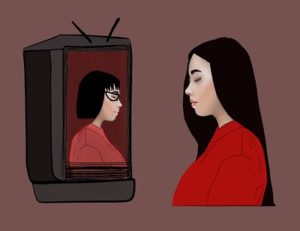Not all Hollywood actors can go for the gold: an analysis on the necessary path to representation
While minority representation in film is only growing, we should question whether it’s Hollywood’s bid to show a shallow understanding of diversity or a true signal of moving forward.
March 6, 2022
When you’re a kid, it’s hard not to be influenced by the opinions and beliefs sprung on you. The casual facts thrown into every prescription commercial are from a professional organization; they must come with some truth. The statistics in the news we read must have come from somewhere or someone that likely knows “better” than you; don’t question it. The winners at world-famous award shows must be the best of the best, the critics as fair as can be.
But when I read about O Yeong-su’s historic Best Supporting Actor win at the Golden Globes for his tear-jerking performance on Netflix’s Squid Game, more than celebrating another of the Asian community’s wins in Hollywood film, all I could think was, “Is this a ploy?”
I was disappointed. I hated that all I felt was doubt, instead of appreciation; distrust, instead of positivity; suspicion, instead of celebration. Deep down, I knew that this win, just as all the others, could be considered a step forward in illuminating once-silenced minorities with golden glory, but in such a historically closed-off industry, I couldn’t stop myself from wondering the intentions behind it: “Tokenism or representation?”
According to MerriamWebster, tokenism is defined as “the policy or practice of making only a symbolic effort.” It’s just like those participation awards that are basically a backhanded compliment, saying nothing more than “you weren’t good enough to get a ‘real’ award, so we gave you something shiny to make everything equal less difficult for us to deal with later.” But in this case, what we’re looking at isn’t the easily-won trophies adorning your childhood bookshelves, but the ones we see on broadcasts, carried proudly by only a select few, and even fewer minorities.
Well, let’s paint a picture of the film industry as a whole. Rasha Ali of USA Today puts it simply, in a way that shouldn’t surprise anyone: “Hollywood is run by (old) white men.”
Statistically, this is true. The owners of the five major film studios (20th Century Fox, Warner Bros Studio, Universal Studios, Paramount Studios, and Columbia Pictures/Sony Pictures Studio) are all white.
And I don’t think this is necessarily bad; this makes sense, Hollywood started out in a time when white men were at the top of the economic classes, and the ability to develop film was a privilege for the rich. I’m not one to know how these current owners got their positions, whether it’s family ties and hard work, and I don’t think I can question the operations of each organization as well.
But another more critical example is in the board members making the nominee decisions. The HFPA board of the Golden Globes was heavily criticized, with star actors such as Tom Cruise and Scarlet Johansson returning awards and cutting ties, after it “faced significant criticism after it emerged none of its members were black,” expressed Gemma Paplow of Sky News.
Oscar voters were primarily white, at 94% in 2014 alone. And while there have been efforts by the academy to invite members of minority ethnicities, “white men do still make up the largest proportion of voters . . . the Academy is hardly speeding towards proportional representation,” Emma Dibdin and Rosie Fletcher of Digital Spy corroborated.
I’m no film critic, but some part of me will question the behind of blunders such as #OscarsSoWhite, where the Academy nominated zero non-white actors, with options from Idris Elba’s complex performance as Commandment in the emotional “Beasts of No Nation” to Tessa Thompson’s fierce portrayal of Bianca Taylor in the highly praised “Creed.” Of course, the white actors selected likely were fierce competitors and it may be entirely possible that they were the best of the best, but it sets a tone that representation isn’t welcomed. With unknown criteria and visible subjectiveness, it’s hard to decipher whether it’s a genuine blunder or there’s an underlying reason.
When award shows such as the Grammys, Oscars, Golden Globes, Tonys, etc. first popped up in the early 20th century, they were simple 15-minute celebrations of the popular silent film industry.
As the ‘40s rolled around, a time still rampant with political suspicion of Communism, nearing the end of World War I, and visible, purposeful inequity among races, representation seemed the least of the public’s concerns. In a time where diversity and representation were on the backburner to resolve there was a new revelation in the public’s minds: a minority could actually be nominated, then win against its counterparts.
Ali writes about Hattie McDaniel’s historical 1940 win, in which “the Oscars were held in a ‘no blacks’ hotel. After accepting her award, she was forced to sit at a segregated table, away from the rest of the ‘Gone With the Wind’ cast.”
McDaniel was one looking forward to this future, stating in her acceptance speech, “I shall always hold it as a beacon for anything I may be able to do in the future. I sincerely hope that I shall always be a credit to my race and the motion picture industry,” as detailed by Seth Abramovitch of the Hollywood Reporter.
But Hollywood wasn’t friendly to her back then. “White Hollywood pigeonholed her as the sassy Mammy archetype . . . The NAACP disowned her for perpetuating negative stereotypes . . . her Oscar . . . was deemed valueless by appraisers and later went missing from the school — and has remained so for more than 40 years. Her final wish — to be buried in Hollywood Cemetery — was denied because of the color of her skin,” explained Abramovitch.
Critics played into the stereotypes of domestic roles as both a woman and African American, while Hattie saw herself as a race-woman, advancing the visibility and accomplishments to look forward to equality.
But Hollywood isn’t much different now. Even after 80 years, there have only been 17 African-American winners and seven Latin-American and Asian winners combined. And while I’m not arguing for movies with minority leads to win solely for the diversity vote, many of these roles perpetuate stereotypes that should be left in the past, such as Octavia Spencer’s winning role as a maid in “the Help.”
These organizations reassert that they are reforming themselves “accordingly.”
“The HFPA [board responsible for the Golden Globes] says it has worked ‘tirelessly’ to make change and has ‘completely overhauled its bylaws, implementing sweeping changes from top to bottom addressing ethics and code of conduct, diversity, equity and inclusion, governance, membership and more’ . . . There are now people of colour involved in decision-making throughout the organisation — from major board decisions, to credentialing and selecting new members,” Paplow corroborated.
After #Oscarsowhite, “they tried to rebrand themselves, and announced new rules of diversity this year, for films to be nominated, calling for representation on screen, in the crew, and at the studio. Yet many predict that filmmakers will take the easy way in and tokenise their characters and crew since the bar is set so low,” expressed Joanna Dias of the Volume Collective.
Specifically, the Oscars’s new inclusion standards, dubbed diversity rules, appear to be a step “forward.”
“In order to be considered for ‘Best Picture’ at the 2025 Oscars and beyond, new criteria must be met. Four categories have been established that call for a quota of marginalised creatives,” explained Beth Webb of NME.
But these standards have been met with outrage and rightfully so. This blatant form of “box checking” drives representation forward for a competitive, not moral or social purpose.
“Black, female, disabled, LGBTQ+, Hispanic and every other marginalised person who falls under the category of ‘other underrepresented race or ethnicity’ runs the risk of being hired for quota purposes and not because their talents are truly valued,” Webb feared.
While film may not have always been objective, under these standards, film wouldn’t be celebrated for its artistic expression, achievements, plot, direction, and more while movies with minorities have an advantage that demonstrates Hollywood still doesn’t see them at an equal playing field.
I’m not going to sit here and blatantly assert that because the boards are made up of primarily white members, there have been an abysmally small amount of minority winners, and tokenism is at an all time high, they are unable to provide some form of representation and should provide said representation to appease a hurt audience. Being nominated by an expert board itself is no easy task. But it begs the question, should I be happy that there were at least nominations? Is a name, a token, being put out there more important than the message it’s sending to the country on the role of representation moving forward not only in film, but in the hearts of young children that are inspired by seeing people that look, sound, and feel as they do?
“At the very least, this enforced change will help to diversify an industry controlled by predominantly white, male gatekeepers,” Webb argued.
I’m partial to this, because not all intentions can be negative, and it does show that in an albeit, twisted way, Hollywood is starting to care. But to truly move forward, what minorities need aren’t the flashing signs of representation, but dimmer lights that shine a focus on their art, as capable members of the film industry. A film industry that should take a long and hard direction of recognizing the merits of these figures with a fair chance, and not taking the easiest direction of shoving representation down our throats instead of action. Hopefully, this band-aid covering the scars of larger systemic issues can fall off and start healing.





